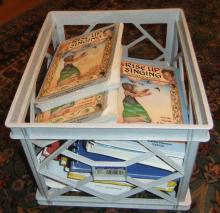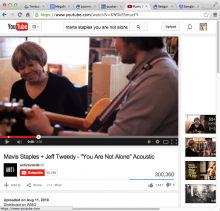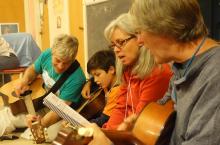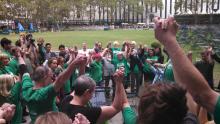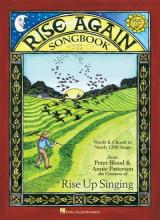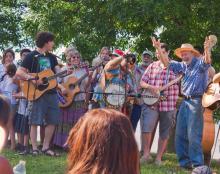Why We Do This Work
By Annie Patterson - July 2017 (in response to FAQ's)
Why did you make these songbooks? Our songbooks Rise Again and Rise Up Singing have 2400 songs in total (lyrics and guitar chords). We made these songbooks specifically with group singing in mind. In creating our songbooks it also became clear to us that they would be good resources for teachers and musicians. We wanted to include songs that expressed our own commitment to peace and justice as well as songs that help lift us up in hard times. I don’t know of any other songbooks that have the same kind of song collection as ours. The author Studs Terkel called Rise Up Singing: a “play-work-fight-freedom hymnal” and we feel that still holds true for both our books.
Our mission is to bring hope through singing to communities around the world. Our songbooks have touched the lives of folks we may never meet. That we get to spread singing far and wide through this work is humbling and also rewarding. Rise Up Singing has sold close to a million copies to date. The last 2 years we have been traveling with our new songbook, Rise Again, teaching songs and sharing the stage with many of the singer-songwriters who contributed their songs to that book. Over the last few years we have helped raise money for many organizations that work for peace, racial justice, immigration and climate justice through our music work.
Did you sing in your family growing up? Singing together was important to both of us in our families. In my family, we sang in the car and in the kitchen. We would sing around the piano on Sundays, or around the campfire on family camping trips. I was encouraged to sing whenever I wanted and I loved that. My mother loved Gilbert & Sullivan, hymns, broadway musicals and any songs in the Great American Songbag. I remember my father singing lullabies to me when I was quite young. Even though he didn’t always sing on key I loved that he sang to me. Singing to young ones provides a closeness that is so incredibly important. That is still one of my most important memories of my dad.
As a vocal coach I have worked with people who have had trauma around singing. Maybe they were yelled at when they were singing or perhaps they were told that they should not sing in front of others. I believe it is a birthright to sing and no one should be told to stand in the back of the choir and mouth the words. There should always be opportunities for anyone who wants to sing to do so in a safe and comfortable environment. Not everyone is at the point where they will audition for a fancy choir, but there should be ways for such folks to find their voices again. I believe that group singing should be a place where that can happen.
Why do you think group singing is important? Singing is a healing activity and at our events we usually encourage the audience to participate. At the end of the evening audience participants often say that they didn’t think they were going to have so much fun. We’ve had people tell us that they plan to find a local singing group and do it again soon. People love being accepted and part of the music at our concerts. That is one of our intentions when doing these singalong concerts!
I feel that the future of this planet depends on us finding ways to come together in local communities across cultural, political, and religious differences. These are unrivalled times in terms of our country being divided. Singing together can help us look beyond our differences. It is one of the best ways I know to find good in each other and just have fun. Take a break from the stresses of the world, from the ups and downs of today’s cell phone lifestyle and overwhelming technologies of social media and just plain sing together. There’s nothing better.
We need community more than ever today, to help share resources and help each other out when times are tough. I feel that coming together in community means finding ways to be patient and respectful with each other and regain our collective sense of humor. When we lead singing this is what we hope for, and we see it happen at our concerts over and over again. It is very hopeful to me that something so simple can bring joy and compassion.
Can you tell me about your relationship with Pete Seeger? Peter & I both worked closely with Pete Seeger over the years. He mentored us and provided a range of support for both of us in our work on our songbooks. Pete loved the wide variety of genres in the songbooks. He often would call us or send us postcards with suggestions for the new songbook Rise Again. Pete asked Peter (Blood) to edit his autobiography Where Have All the Flowers Gone which ended up bringing us all closer in many ways.
I fondly remember visiting Pete and his wife Toshi at their home overlooking the Hudson River on our oldest son’s birthday. Their lifestyle was a simple one but music and celebration were always a part of the fabric of their home. Before we knew it birthday banners were made and a birthday cake of stacked pancakes was presented to our newly 16 year old. Everyone was involved and drawn into the fun of it.
Pete and Toshi mentored many folks over the years. Their love of life and dedication to making a better world has been a great gift that effected many of us on a deep level. We were lucky to have had the opportunity to know them and to have Pete’s supportive presence in our lives.
What would you say are your musical interests right now? I love leading singing but I am a jazz vocalist as well as a folk performer and most recently a record producer. When I was in college I hosted a folk radio show and then went on to hosting a radio show on WXPN in Philadelphia, as well. I have always loved many different styles of music but those radio shows expanded my knowledge and awareness of different types of folk music. I loved acoustic folk music. Ola Belle Reed, The Carter Family, Doc Watson, Emmy Lou Harris and Libba Cotten were all big influences on me in those days. The banjo has been a particular love of mine since I was 18 years old. I started playing bluegrass style but quickly found my way to playing old timey frailing or clawhammer style of banjo. I accompany myself on banjo at all our concerts as well as guitar. I have also been singing jazz in a swing band (Girls From Mars) for over 3 decades. We sing Ella Fitzgerald, Nat King Cole and a variety of songs from the 1930’s and ‘40’s. I love the intricate harmonies of early swing trios, as well.
Harmony is really at the heart of what I love about group singing. However, it did not come easily to me. I sang in many choirs as a girl so I learned to read parts but improvising harmony was much harder for me. My mother sang 2 part songs with me in the car which helped me hear the counter melodies. Singing songs with my sister or my cousin where we challenged ourselves to sing harmonies eventually helped me hear the chords and pick out the harmony. It still is not the easiest thing for me but I love it. Sometimes at our singalong concerts we’ll teach the melody, then once everyone has it down I will break into a harmony. That gives me tremendous joy.
What is the difference between a regular concert, a singalong, and a singalong concert? We’ve been leading singing a long time, since before Rise Up Singing came out in 1988. I’m not sure when we coined the term “singalong concert”, but for years we just did sing alongs where the whole evening was given over to allowing the audience to ask for whatever songs they wanted out of the songbook. We’d pass out songbooks for everyone to use and any song requested was sung by the whole group. As song leaders we provided the rhythm, kept the beat steady and encouraged the audience singing. This shifted somewhere along the way when we had more songs we wanted to teach.
We still loan out songbooks for the events and there continues to be a sing along component to the evening but when we began to travel around with our songbooks as full-time musicians we realized how many songs we wanted to teach folks and that it was also a good opportunity for me to take a few moments to perform a couple songs as well. I am a performer. I love to give concerts. I found that I really wanted to have part of the evening devoted to singing a song as a gift to the audience, perhaps with them singing on a chorus but perhaps not. It allows for a little break from the group singing component and helps create a different musical arc to the evening.
Our events now are a little more scripted and planned out. We often have a theme to our shows. This came about as a direct reaction to seeing a real desire to teach folks songs that give a sense of renewal and hope. We still love a good upbeat sing-along and enjoy leading weekends completely devoted to singing whatever folks want to sing, but the community “singalong concerts” are a slight variation on that. We often take the opportunity during the evening to share a few stories of our work with Pete Seeger or our travels around the country. Even though we like to teach new songs we always incorporate old favorites into the evening.
What do you envision as some of the next steps for you in this work? I still perform on my own and with other musicians. Peter and I are always thinking about what’s next for us, individually and together. I’m hoping to spend some time doing a bit of songwriting this fall and I will also go on a couple small tours with my swing band. Last year I produced a recording for a Mennonite & Brethren organization called Shine. It’s a 30 song companion cd for an Early Childhood Sunday School curriculum. I hope to do more recording in the near future. Peter and I have been married 34 years and find working together to be as rewarding as it is challenging. We plan to continue traveling together but I may do more performing and song leading on my own as he is called to do more Interfaith work around Climate Change. We’ll see. We try to be as faithful as we can in what we do. I don’t think we’ll ever stop community building work through music, although it may shift and change in the future.
Bios for Annie & PeterPromo materials (articles, radio interviews, etc.)





